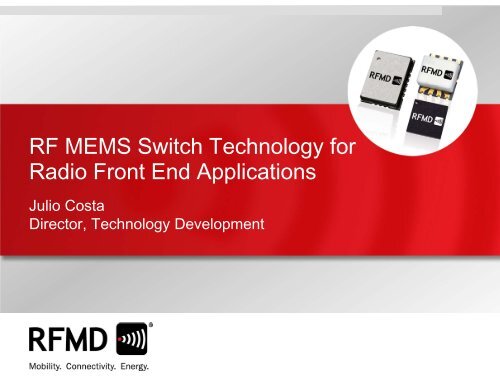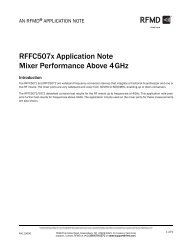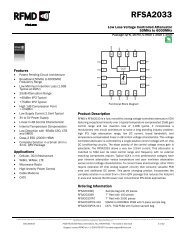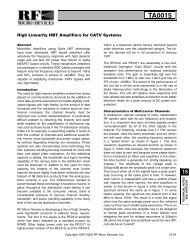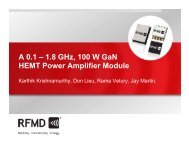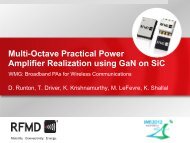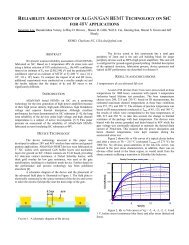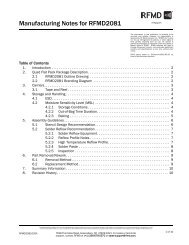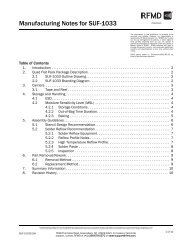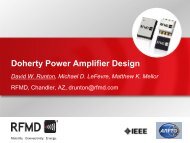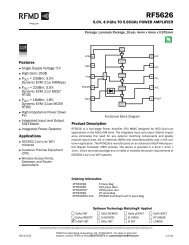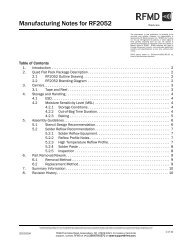RF MEMS Switch Technology for Radio Front End - RF Micro Devices
RF MEMS Switch Technology for Radio Front End - RF Micro Devices
RF MEMS Switch Technology for Radio Front End - RF Micro Devices
You also want an ePaper? Increase the reach of your titles
YUMPU automatically turns print PDFs into web optimized ePapers that Google loves.
<strong>RF</strong> <strong>MEMS</strong> <strong>Switch</strong> <strong>Technology</strong> <strong>for</strong><br />
<strong>Radio</strong> <strong>Front</strong> <strong>End</strong> Applications<br />
Julio Costa<br />
Director, <strong>Technology</strong> Development
Outline<br />
• Cellular system evolution<br />
• Tunable <strong>RF</strong> <strong>Front</strong> <strong>End</strong>s<br />
• <strong>RF</strong>CMOS-on-SOI technology<br />
• <strong>RF</strong>MD <strong>MEMS</strong> <strong>Switch</strong> <strong>Technology</strong><br />
• Measured DC / <strong>RF</strong> / Reliability Characteristics<br />
• Conclusion
Cellular Market by Air Standard
Multiple Band Configurations Driving 3G TAM<br />
Broad product portfolio required to capture<br />
3G <strong>Front</strong> <strong>End</strong> TAM—especially switch,<br />
filter, and duplexer combinations
Phones of the Next Decade
3GPP Band Specifications
<strong>MEMS</strong> Value Proposition<br />
• <strong>MEMS</strong> is beneficial in the Cellular FEM if it:<br />
• Enables smaller and higher per<strong>for</strong>mance based front end at or below current<br />
technology reference price<br />
• Multiband reconfigurable front ends in 2012<br />
• Smaller size/improved per<strong>for</strong>mance will enhance uptake of MM
SP8/9T Cost/Per<strong>for</strong>mance vs. <strong>Technology</strong>
Market Motivation<br />
• <strong>MEMS</strong> <strong>RF</strong> contact switch has lower insertion loss <strong>for</strong> multi-mode<br />
applications<br />
• Improves Multi-Mode TxMper<strong>for</strong>mance<br />
• Increased Module PAE by up to 10%<br />
• Removes per<strong>for</strong>mance objection to converged architecture<br />
• <strong>MEMS</strong> <strong>RF</strong> switch has superior Isolation/Harmonics<br />
Per<strong>for</strong>mance (>15dB compared with solid state)<br />
• <strong>MEMS</strong> offers adaptability/tunabilityat similar per<strong>for</strong>mance<br />
• <strong>MEMS</strong> <strong>RF</strong> <strong>Switch</strong><br />
• Is cost competitive to pHEMTin multi-throw application<br />
• Lower harmonics, 10-15 dB<br />
• Grows die ~10 -20% to account <strong>for</strong> de-bounce, calibration I/O
Tunable 3G FEM: <strong>MEMS</strong> Opportunity
Antenna Tuning w/ <strong>MEMS</strong><br />
• Dynamic antenna tuning could tremendously simplify Power Amplifier TRP<br />
• Leads to smaller PA sections, easier to adapt/tune<br />
• May be accomplished with either Capacitive/Contact <strong>MEMS</strong> devices
From Our Friends Across the Pond<br />
• Demonstrated antenna tuning in cellular band with capacitive <strong>MEMS</strong> switches<br />
• <strong>MEMS</strong> division acquired by EPCOS, a leader in cellular FEM
So Why Aren’t <strong>MEMS</strong> <strong>Switch</strong>es in Cellular Handsets?<br />
The Bad<br />
• HV Charge pumps required <strong>for</strong> actuation (30-100V versus 3V)<br />
• Hermetic packaging/sealing required/Flip Chip Requirements<br />
• Relatively slow speed versus solid state (5-50us versus
What Kind of <strong>RF</strong> <strong>MEMS</strong> <strong>Devices</strong> Do We Need?
<strong>MEMS</strong> <strong>Switch</strong>es: Contact vsCapacitive<br />
• Both switches have positives/negatives
Cellular Drives Wafer Volume and Cost Reductions
<strong>RF</strong>MD <strong>MEMS</strong> 1-1-1 <strong>Switch</strong> <strong>Technology</strong>
<strong>MEMS</strong> Wafer Level Packaging<br />
• Wafer level packaged demonstrated suitability <strong>for</strong> hermetic<br />
applications (similar to <strong>RF</strong>MD’s SAW process)
<strong>MEMS</strong> and pHEMT Insertion Loss
<strong>MEMS</strong> and pHEMT Harmonics
900 MHz Ruggedness/Power Handling Results<br />
Test Conditions<br />
• Maury on-wafer loadpull<br />
• Au alloy contacts in WLP<br />
• Pin= +36 dBm VSWR=15:1 with<br />
• 5 degree phase increments<br />
Results<br />
• 49 switches from a single wafer<br />
(48007.002.03) were tested<br />
• At room temperature, switches met<br />
specification and survived +36 dBm and<br />
15:1 VSWR<br />
• Either VSWR and/or Pin were then<br />
increased to take switches to destruction<br />
• <strong>Switch</strong>es failed at either 20:1 VSWR and/or<br />
+38dBm<br />
• Almost all failures were due shorts between<br />
source and drain
Charge Pump <strong>for</strong> <strong>MEMS</strong>
<strong>Switch</strong>: <strong>MEMS</strong> vs pHEMTSP8/9T
Antenna Tuner <strong>MEMS</strong> Implementation
Antenna Tuner <strong>MEMS</strong> Implementation<br />
* Breadboard results with discrete <strong>MEMS</strong> switches/capacitors<br />
Insertion loss < 0.5 dB1 dB <<br />
Insertion loss > 0.5 dB<br />
1800MHz<br />
700MHz<br />
870MHz<br />
2690MHz
Reliability Capability<br />
Accel-<strong>RF</strong> example data file <strong>for</strong> 0 dBm hot switching part (Au-Au). Fail open at 117M<br />
cycles. We need 1-2 order magnitude improvement <strong>for</strong> TX-RX switching
Summary<br />
• <strong>RF</strong> <strong>MEMS</strong> Contact <strong>Switch</strong> Process on <strong>RF</strong>CMOS-SOI presented<br />
• Work underway to prove needed reliability levels and acceptability by<br />
cellular system architects<br />
• 3G/4G System Requirements could be the large driver <strong>for</strong> <strong>MEMS</strong><br />
switch technologies<br />
• High per<strong>for</strong>mance mode switches<br />
• Tunable antenna networks-Adaptive Power Amplifier


